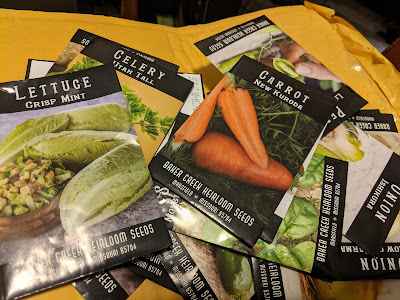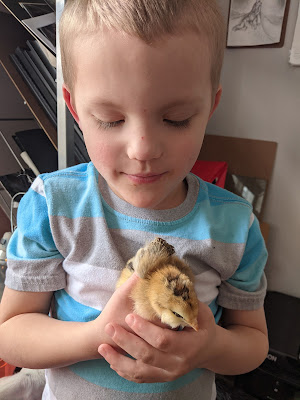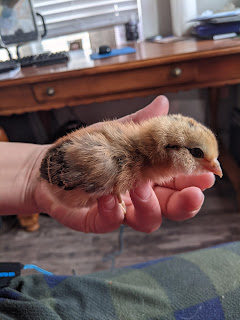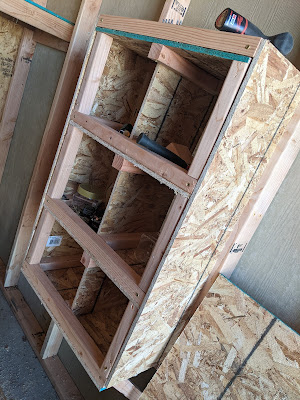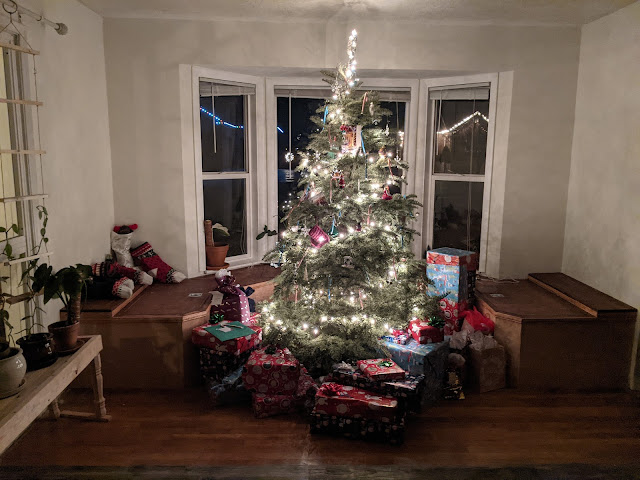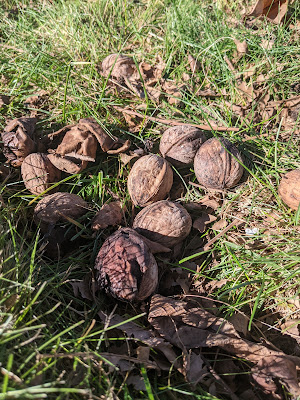Large leafed indoor plants are some of my favorites; I have several varieties, and a list of others I would like to add to my collection, but there is one that I have loved for some time now, and have found it the most difficult of plants for me to keep.
Calathea Orbifolia.
To be honest, all calatheas have been difficult for me actually, including the Calathea Warscewiczii that I inherited from my sister (THANK YOU FOR THE PLANTS!). It is just about dead and I'm about to repot that sucker and start from scratch with what I know just to try and bring it back from the brink. But the plant I really love is the Orbifolia, and I HAVE to figure it out! It has the most beautiful wide dark leaves with silvery stripes running through it, and I love how full it is, just like my monsteras.
The first Calathea Orbifolia that I purchased was a little tike with about ten leaves on it, none larger than the palm of my hand, and it had a new curled up leaf getting ready to pop out. I was so sure I would be able to keep it alive, especially after raising a lemon tree from a seed, keeping and propagating four vanilla vines into twelve long vines, and watching my first cacao tree branch out into a true mini tree. I had raised difficult tropical varieties of plants in the cold of Connecticut, Oregon, and then into Utah. My knowledge is not complete, but how hard could a plant bought from hardware store be?
Foolishness does not come close to how bad my choice was. My understanding of this plant has been tested over and over and over again, and I found that I had not prepared sufficiently before buying it. Obviously this was an impulse buy, and later I found out while doing research on my then dying plant, that though it is being to be sold commonly, it really is not happy in dry climates, climates that get cold at all, too little sun, any direct sun, the soil must hold moister but also must drain very well, needs fertilizer ONLY during growing season (which varies depending upon your climate), and any fertilizer that is given must be in extremely low doses once a month, plus if you give it too much fertilizer or fertilizer out of season it will hate it. Humidity MUST be above 50%, preferably higher, and temperatures preferred between 65 degrees Fahrenheit and 80 degrees Fahrenheit, but likes life closer to 75 degrees. Also, filtered or distilled water is a must, nothing else will work.
In essence, if I screw up any of that above my plant will not grow, will start to die, and will shrivel up. Even if I do it all right it might still shrivel up. Or so sayeth the experts online.
Pretty much I have a love hate relationship with this plant, because I've had the one for a year now. A YEAR! And for the first time I watched one of it's leaves grow taller, uncurl and perk up. I had a humidifier on it for most of that year, it took forever to figure out what kind of light it actually wanted, because it doesn't want deep shadow but at the same time it's leaves would yellow and the whole plant would throw a temper tantrum if it ended up with ANY direct light. I finally got into a better habit of watering it with filtered water, which is somewhat annoying, but all my plants are happier with it, so it takes almost an hour to produce the filtered water enough for all the plants and water them. Oh well, at least they're all thriving! Kind of...
Anyways, I've finally added to my plant a plastic base with rocks in it for the pot to sit on and a bunch of water in with the rocks to raise the humidity level. I have a humidity/temperature reader right next to the plant just to keep an eye on it. I've found a spot in my house that the plant seems to enjoy sunlight-wise. Now I just wait, right?
While waiting... I bought another Calathea Orbifolia from the grocery store of all places. They really shouldn't sell these at regular stores, it just brings depression into a person's life when they buy them then watch them die within the month. This particular orbifolia is about four times the size of my current baby; sometimes if you buy a more mature plant it has a better chance of surviving. I've had it only a few days now and it seems perky and has a few new curled up leaves waiting to climb upward and open as well.
I put it in my normal mix for regular potted plants that need some extra drainage; a mixture of basic indoor potting mix put together with a cactus mix. The potting mix allows for proper nutrients and will trap moister because of it's material, while the cactus mix breaks up the potting mix into moister loving clusters that the plant enjoys, rather than allowing it to be one giant soggy mess. I've found great success in this mixture with most my plants, including my fruiting tropicals and my normal house plants, such as my philodendrons, pothos, maranta, and a whole slew of other ones. How I cover my plant's individual needs is through fertilizers, water pebble trays or humidifiers, and placement to sunlight. Almost all of my plants are also in ceramic or glazed ceramic pots depending upon their needs.
Back to the Calathea Orbifolia; I have two now. A baby plant and a 'teen' plant. The teen will be my test subject now. Transplanting it from a plastic pot into a clay pot has occurred, with a nice mix of Audrey's custom soil blend, a plastic pebble and water tray placed beneath. Let the experimenting begin! The first one is with fertilizers; I usually trust Logee's suggestions on general care and fertilizers, which for Calathea in general they suggest a 15-15-15 or lower balanced fertilizer. I've bought a 10-10-10 to try out since I couldn't find a 15-15-15 at my local store. They also suggest a water-soluble fertilizer. Mine is not, but I can always dissolve it before adding, or I can follow some suggestions and add the sprinkling of fertilizer farther away from the base of the plant so as not to burn the root system.
I really want to see a tiny bit more growth out of the plant first, showing that it has adapted to it's new pot and position in our home, then add the fertilizer a tiny bit at a time. I'll try to keep record of this experiment, especially since I want to figure out how to grow and propagate these tropical varieties in a colder climate. I'm sure it can be done!
As my two Calathea Orbifolia grow or decline I will add updates. I can't help but want to figure this out, maybe because it's a puzzle, maybe because of my pride at having kept everything else alive and flourishing, or maybe it's just because I really like this plant. Maybe it's all those reasons, either way I'm going to keep at it until I get it right!
Update: my Calathea Warscewiczii was dying, I decided to pull it out of the pot, double check it's roots for rot, separated it into three parts from the dead section, found that it was gobbling up water VERY quickly, potted it into three different pots, and am now waiting. They aren't very happy, not even after four days. I think I'm going to have to scrap this experiment, but I have one more thing I want to try; I'll pull one out and put it in a vase with water as if rooting it again. I think I might have some luck with it, but only time will tell. They look terrible right now.
So we are starting with just about nothing on our half acre dream; directly behind the house are some larger, mature juniper trees and another tree I'm not sure of yet, and then just to the south east of our house is the giant 'bean tree', that is the kids play area. Against the east side of our house are some Rose of Sharon bushes, and near the driveway are a few shrubs. We have one small tree, I'm not sure of the species, in our front yard, and that's it.
The small tree is gonna go. I have no idea why anyone would place that tree there like that, but I have other plans for that area that I think would be more appropriate. The Rose of Sharon bushes I'm keeping for now, and the other trees I'm keeping as well, as well as the hedges...perhaps.
So that gives me...about...75% of the landscape open to gardening. This makes me happy in soooooo many ways and I'll tell you why; first, it means I've got plenty of room to put in trees, bushes, veggie garden, herb garden, and all the flower beds I could hope for. We sit on half an acre after all! Tim and I are both excited about the space we have and how flexible our lot is. The water level is high, our land has been worked a lot already and the soil is already PERFECT, a sandy loam that's easy for plants to grow in and us to work with, and on top of all that it is flat with only a fence on one side. Second, I love growing my own food, eating it fresh from the garden, storing it, and watching my kids enjoy it as well. I remember gardening ever since I was young, watching pear, apple, and cherry blossoms come and go, and then the little fruit growing until we would climb the trees and pick it all for eating and canning. There's something special about growing your own food. Third, we live in an area that is plagued by droughts often, and there are a lot of perennial flowers and plants that I can replace the lawn with in order to satisfy the need to use less water, my desire to see more flowers and garden in general, and to decrease the amount of time my husband has to use to mow the lawn. Lawns can be nice, and we're keeping some for kids to play in, but honestly they are the most boring, water and time wasters I have ever seen. I don't know why people bother with them so much. Get some perennial plants, bushes, and trees. In the long term they are cheaper, use less water/care for themselves better, and will always make your home more inviting as long as you give them a trimming twice a year, if that.
My plan is to implement a cottage style garden, full of flowers that will attract birds, butterflies, bees, and of course people. I want herbs drying in my shed, grapes on trellises/fence , a wall of fruit trees, and hidden spots to explore throughout our yard. This year though, our first year hear at our house, Tim and I are focused on getting a few basic necessities put in place to help provide food and begin to shape our yard better. So, the first things going in this year are the fruit trees, the berry patch in front of the grapes, the grape vines, our chicken coop and run, and of course our veggie garden. We have planned it and other parts of our yard out for this year, though plans do change on occasion and this map of our yard will probably be updated once in a while.
Post settings Labels Featured,Home & Life,Plants & Pets, No matching suggestions Published on 2/27/22 3:27 PM Permalink Location Options Post: Edit
Gleaning is when you collect excess food or usable items/plants from neighbors, nature, etc. I have gleaned a bit here and there at various times in my life, got comfortable talking with neighbors and other's when I'm curious to see how flexible they are with their goods. Now that we have our own home and I can experiment a little more, I think gleaning and trading will come in great use, especially since we live in a semi-rural area and most of our neighbors have livestock and farms. Some of our neighbors have already brought us corn on the cob, peaches, apples, and cantaloupe.
During some of our neighborhood walks I noticed a few houses that had tradeable foods, excess on the ground, and things in their yards that perhaps they might be willing to let go of. One such is a lovely lady who has a couple of walnut trees in her front yard. The walnuts were littering the ground; hundreds of them, all over the sidewalk, in the road, scattered in the pockets of the grass lawn. It took a few visits to finally knock and get her at the door in order to ask properly for the walnuts, but when we did finally get ahold of her she was very kind, mentioned that only her husband eats them once in a while, so we were welcome to bring a back and collect a bunch.
Quinn went to school, Perrin and I played a bit, cooked breakfast, took care of a few things, and then picked Quinn up from school. After lunch Perrin went down for nap and Quinn and I walked to the neighbor's yard, bag in hand. He worked hard and focused well, collecting as many walnuts as he could around the yard. We collected so many of them before bumping into the mail lady. She noticed our walnut gleaning and asked about what we were up to. I mentioned the asking about collecting them and asked if she wanted some. Our mail lady was so happy about the little bag of walnuts we were able to give her. Both of us, the mail lady and myself, have never roasted walnuts and were excited to learn how.
Hopefully she'll figure it out, and hopefully I will too!
Quinn had a good time and I felt like it was an opportunity not wasted to teach my son about how to find an extra food source. Though I'm no homesteader, and we're definitely still pretty close to the city and city ways, but I think of our little half acre as an opportunity to start learning and practicing how to be more self-sufficient, and that includes teaching my children as we go. If I can replace our store bought produce, meat, and eggs, many of our snacks and even some of our juices, I'd be ecstatic! Collecting walnuts and making good connections with our neighbors is how all of those goals begin, because creating those good relationships within our community is vital to self-sufficiency as well I believe. Being able to provide for yourself and family when completely alone is great, but you can really thrive if you have a community ready to share, trade, and help one another.
I plan on making homemade bread for our neighbor with the walnuts in return for their generosity. I don't have a lot more to share yet seeing as we haven't started our own gardens, our chickens, or hunting, but I hope to help other's in the future and get a good community sharing sense going on. We hope to bring to our neighborhood pears, peaches, apples, grapes, meat from hunting, eggs, chicken, and when our green house is up and running a regular supply of vanilla beans, cacao pods, bananas, and maybe a few other specialty varieties.
Hopefully we'll get to that point, but today started with gleaning walnuts with my son. In the end we had 5lbs of walnuts, shells on still, so there's plenty of work to do with them. Guess it's time to buy a nut cracker!





















